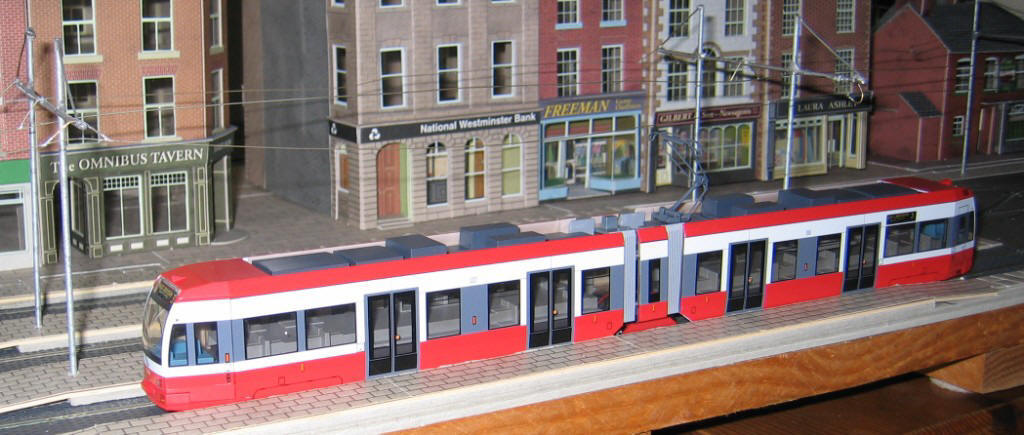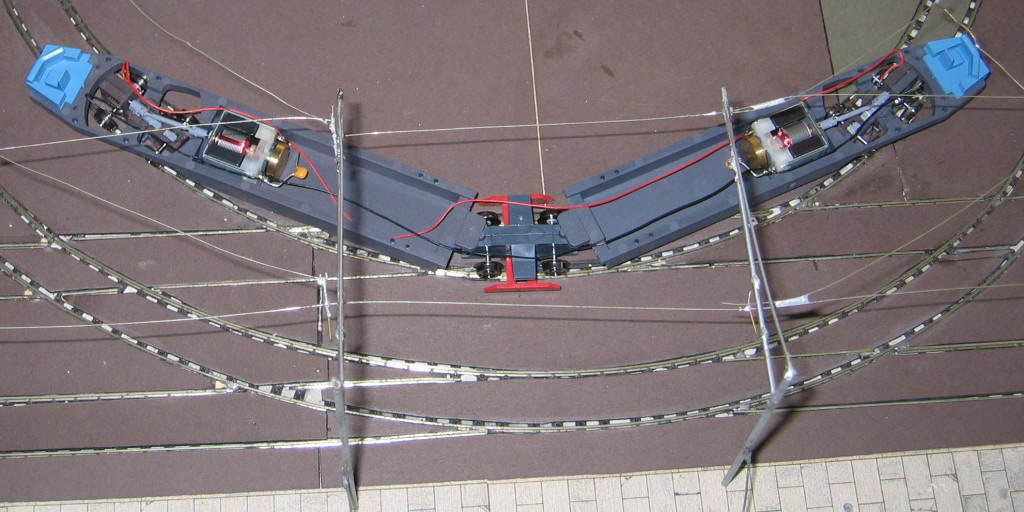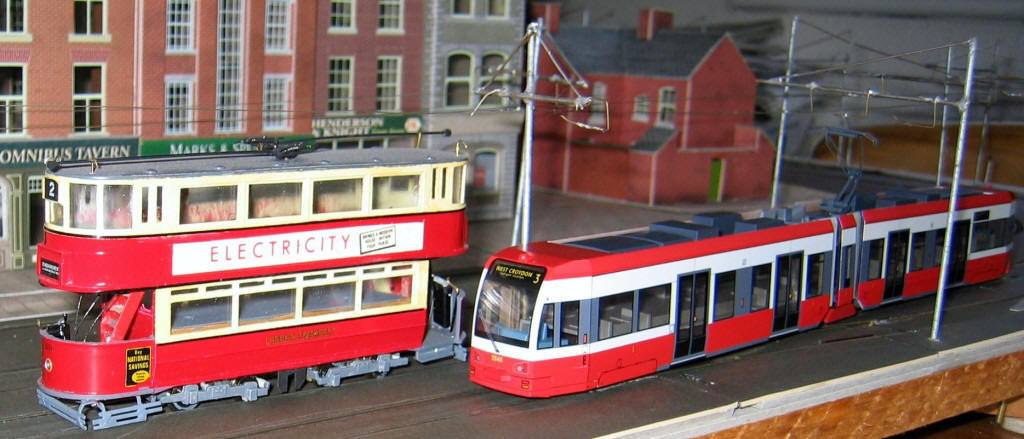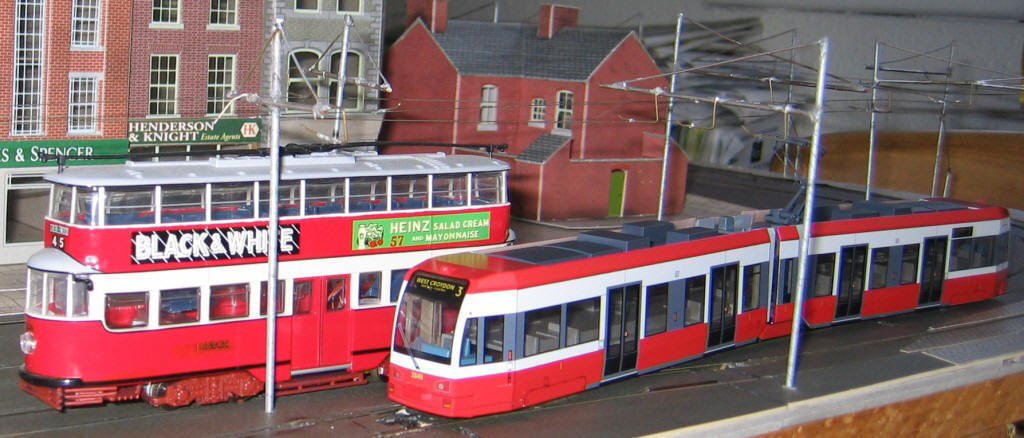
Halling 1:87 Bombardier CR4000 Croydon Tram
Released August 2007
Reviews by David
Orchard, Clifford Reed and Jim Snowdon
Click on the
pictures to see the larger images
This introduction to this review is taken almost verbatim from
the late Stephen Parascandolo's
Croydon Tramlink website, and we are
grateful for permission to replicate his words.
"Croydon Tramlink is not the first tram system in Croydon - old
London trams used to run through the town along the A23 which was London
Road, North End and High Street. The threat from buses both electric and
diesel came early. The Addiscombe route which branched off the mainline
at the Almshouses and up George Street, passing
East Croydon station and into
Cherry Orchard Road, closed in 1927.
Trams along North End ran until
7th April 1951
and at that time were trunk routes 16/18 (Purley - Embankment) and 42
(Croydon Greyhound - Thornton Heath). They were closed as part of Stage
3 of Operation Tramway. By then, the trams and infrastructure were life
expired. Unlike those on the continent, they were not updated but
cleared away to make way for buses and cars.
Now, those cars have created huge traffic problems in the Croydon area.
A study was carried out by London Transport (LT) and British Rail in
1986 which covered all of
London. From 1990 Croydon Council and LT worked to promote Tramlink.
Public consultations took place during 1991 discussing routes and
testing public feeling - 80% of those asked felt Tramlink was a good
idea. A bill was developed and in November 1991 was put to Parliament.
Some amendments were made and the Croydon Tramlink Act received Royal
Assent on
21st July 1994
giving London Regional Transport (LRT) the legal power to build and run
Tramlink.
Whilst Parliament were considering the bill, Croydon Council, LT
and three private companies worked together to start the design process.
This group was disbanded in 1995 when Tramlink went out to tender across
Europe. As with many new schemes, the contract available was a Design,
Build, Finance and Operate Concession. The successful consortium was
Tramtrack Croydon Limited (TCL) who now have a 99 year concession to run
the system.
TCL is made up of:
CentreWest Buses Ltd. (later part of the First Group). They have now
become the tram operators as Tram Operations Ltd (TOL)
and later First Tram Operations Ltd.
Bombardier EuroRail - they have designed and built the trams
themselves. They also have the contract to maintain and repair the fleet
in service. They are now known as Bombardier Transportation.
Royal Bank of
Scotland and 3i - these have provided the finance for the project.
Sir Robert McAlpine/Amey Construction Ltd (Construction Joint
Venture, CJV) - who constructed the system.
The total capital cost was estimated to be £200m of which £125m was
provided by Central Government in recognition of the benefit to other
road users and the easing of congestion.
Work started in January 1997. This included the closure of the two
National Rail lines. The construction process was scheduled to be
complete for an opening in November 1999. Unfortunately, a variety of
problems with the contractors and with the mass of legal contracts
caused a slight delay. The first tram was delivered in October 1998 to
the new Depot at
Therapia Lane
and testing on the sections of the Wimbledon line began shortly
afterwards. The first tram to run under its own power on the streets of
Croydon was 2535, early on June 16th 1999.
The official opening finally took place on
10th May 2000
at New Addington when Route 3 opened to the public. Route 2 to Beckenham
Junction opened on 23rd May 2000 with the Route 1 from Elmers End to
Wimbledon
opening a week later on 29th May 2000."
The London Transport Museum commissioned the model reviewed from Halling in Austria, who had already had already produced a 1:87 model of the Bombardier Cologne KR4000 tram from which the Croydon trams were derived. The Croydon model was released by the Museum in August 2007 (surprisingly quietly! ed.)
Click on the pictures to view the larger images
David Orchard wrote (of the motorised version):
 Most of Halling's motorised articulated trams are built exactly
the same way: each end bogie pivots on a circular aperture mounted in a
fairly solid chassis moulding, and has both axles driven via a small
half-inch long grey plastic 'prop shaft' (strictly a cardan-shaft or 'kardanwelle'
in German - the reason for saying this will become apparent). Each prop
shaft connects to a substantial longitudinal motor via a fairly simple
click-in universal joint (UJ) at either end, and each bogie has both
axles electrically interconnected via both motors, providing very good
track pick-up indeed. The centre portion is a fixed bogie floating by
fairly solid pivots to each of the two chassis mouldings, and has a
clip-on body unit including four rigid articulation "curtains" (these
can be trimmed back or their location slots extended in order to tackle
sharp bends. Unlike on other Halling models, the motored bogie clearance
does not need
to be increased for sharp curves, thank goodness. )
Most of Halling's motorised articulated trams are built exactly
the same way: each end bogie pivots on a circular aperture mounted in a
fairly solid chassis moulding, and has both axles driven via a small
half-inch long grey plastic 'prop shaft' (strictly a cardan-shaft or 'kardanwelle'
in German - the reason for saying this will become apparent). Each prop
shaft connects to a substantial longitudinal motor via a fairly simple
click-in universal joint (UJ) at either end, and each bogie has both
axles electrically interconnected via both motors, providing very good
track pick-up indeed. The centre portion is a fixed bogie floating by
fairly solid pivots to each of the two chassis mouldings, and has a
clip-on body unit including four rigid articulation "curtains" (these
can be trimmed back or their location slots extended in order to tackle
sharp bends. Unlike on other Halling models, the motored bogie clearance
does not need
to be increased for sharp curves, thank goodness. )
 The
main body units clip onto the chassis mouldings rather tightly, and in
between there is a 'false floor' incorporating seat backs etc. This
floor is always set 'high' to accommodate motors, even in un-motorised
versions. In the Tramlink model it isn't very firmly fixed - others
Halling models are better - and I recommend
PVA glue to lightly fix it in place (not
plastic solvent glue, or you'll weld it solid !) The
other tip not
in the instructions is that the front fender has to be removed before
the body unit will lift off - unclip it
downwards for Tramlink and
forwards for all the
other models like K5000 ! Good news is that the Tramlink model
incorporates weights in the body unit roofs - a good point not always
seen on other Halling models - and the pantograph is the later
strengthened version that does not fall apart.
The
main body units clip onto the chassis mouldings rather tightly, and in
between there is a 'false floor' incorporating seat backs etc. This
floor is always set 'high' to accommodate motors, even in un-motorised
versions. In the Tramlink model it isn't very firmly fixed - others
Halling models are better - and I recommend
PVA glue to lightly fix it in place (not
plastic solvent glue, or you'll weld it solid !) The
other tip not
in the instructions is that the front fender has to be removed before
the body unit will lift off - unclip it
downwards for Tramlink and
forwards for all the
other models like K5000 ! Good news is that the Tramlink model
incorporates weights in the body unit roofs - a good point not always
seen on other Halling models - and the pantograph is the later
strengthened version that does not fall apart.
 Unfortunately
this is not true for the bogie units. These can easily fall out of the
chassis moulding either during postage or with rough handling. It is
fairly simple to click the bogies back into place (watch out you don't
trap the wires, though), but meanwhile the prop shaft will have fallen
out either into the box (if you are lucky) or onto the floor (if you are
less lucky.) It is very inconspicuous and looks like a small maggot; if
you manage to drop it into bird feed you have really lost it ! It can
be replaced in the tram from below with enormous difficulty, or from
above (remove the body and false floor first), using tweezers and care
to align the UJs, with only moderate to severe difficulty. If you lose
it altogether, email
www.halling.at to ask for a set
of six replacements. Halling staff have reasonable general English, but
don't know technical terms, but use the words "kleine kardanwelle" and
you should be understood. I got mine for free; I suspect I wasn't the
first to ask.
Unfortunately
this is not true for the bogie units. These can easily fall out of the
chassis moulding either during postage or with rough handling. It is
fairly simple to click the bogies back into place (watch out you don't
trap the wires, though), but meanwhile the prop shaft will have fallen
out either into the box (if you are lucky) or onto the floor (if you are
less lucky.) It is very inconspicuous and looks like a small maggot; if
you manage to drop it into bird feed you have really lost it ! It can
be replaced in the tram from below with enormous difficulty, or from
above (remove the body and false floor first), using tweezers and care
to align the UJs, with only moderate to severe difficulty. If you lose
it altogether, email
www.halling.at to ask for a set
of six replacements. Halling staff have reasonable general English, but
don't know technical terms, but use the words "kleine kardanwelle" and
you should be understood. I got mine for free; I suspect I wasn't the
first to ask.
That said, it's a super model with eight out of twelve axles driven, just like the full-size Croydon car, and (like all Halling's twin-motor models) runs beautifully and will tackle mild gradients with ease. (The first of this type of Halling car - the K5000 - originally came out with one motor and only one driven bogie. It worked nicely on the level, but that was it.) For those who want to motorise an un-motored Tramlink car, there seems to be a Halling motorising unit for the Vienna E/E1 "steering rubbing car" (their own website terminology - the German is "Gelenktriebwagen" which means Articulated Motor Tram) under their reference 2001004 A / E drive where all the parts look as if they would fit Tramlink (Halling parts are pretty highly standardised.)
 The
model actually incorporates two electrically-connected motors, each
driving an end bogie, and each equipped with flywheels to aid smooth
running (score
ten points here - this model will run really well.) Unlike the K5000
models from the same manufacturer, the wheel flanges are 0.5mm rather
than 1.0mm, reflecting tramway rather than railway practice.
The
model actually incorporates two electrically-connected motors, each
driving an end bogie, and each equipped with flywheels to aid smooth
running (score
ten points here - this model will run really well.) Unlike the K5000
models from the same manufacturer, the wheel flanges are 0.5mm rather
than 1.0mm, reflecting tramway rather than railway practice.
The motor drive mechanism is precisely the same as on the K5000, which
means that there is a tiny little inch-long plastic cardan shaft that
occasionally drops out and gets lost. But a nice lady called Suzanne
Rupprechter at
Halling
will send you
free-of-charge a pack of 10 of them if you send her a friendly email. (I
think they are used to doing this by now!) Apart from that, the
mechanisms are very tough.
It was possible on the K5000 to shave a bit of plastic off the centre
section and the floor section by the motor bogies to enable the model to
negotiate 200 mm / 8 inch radius curves. Looking at the Croydon model,
this looks feasible too (also shave a bit off the 'skirt' of each of the
main sections), as it's just that bit longer than the K5000, but
correctly so.
I once tried modelling a scratch-built articulated tram in 1/24 scale,
and even in this much larger scale it is difficult to get the functional
roof linkage over the articulation to work properly. I would suggest in
the small scale that stretched fuse wire (unravel 10 or 15 amp fuse wire
from its card, put one end in a vice and tug hard on the other with
pliers. Result: 1 yard of perfectly straight modelling wire, easy to
bend to exact shape, glue or solder, and easy to paint) could be used to
make up much of the missing overhead detail, combined with an 0.5 mm
drill either in a jeweller's augur or a small 12v electric drill to make
the tiny location holes in the roof mouldings.
Finally,
the Tramlink model is precisely the same width (29 mm) as a Corgi
Feltham, even though technically they are in slightly different scales.
To my eye, they look fine together. I have run the K5000s along with
motorised Felthams on my layout, and the performance is compatible.
Clifford Reed wrote:
 I
only have an un-motorised Croydon tram at present. The finish is very
good on the outside of car 2545. The destination blinds are separate to
be fitted inside for routes: 1 Elmer's End -
Wimbledon, 2 Beckenham Junction -
West Croydon,
3 New Addington - West Croydon: all in both directions! Mirrors are
included to be fitted later, however there is no advertising or
lettering for the outside other then the number. The roof
detail and pantograph all look good and working (no power). My only
comment on the down-side is the one level floor at about waste height in
the doors (just below window height!!), but the tops of seats are
moulded into this: the cab section is well represented with driverís
seat and console cleanly modelled in one colour plastic.
I
only have an un-motorised Croydon tram at present. The finish is very
good on the outside of car 2545. The destination blinds are separate to
be fitted inside for routes: 1 Elmer's End -
Wimbledon, 2 Beckenham Junction -
West Croydon,
3 New Addington - West Croydon: all in both directions! Mirrors are
included to be fitted later, however there is no advertising or
lettering for the outside other then the number. The roof
detail and pantograph all look good and working (no power). My only
comment on the down-side is the one level floor at about waste height in
the doors (just below window height!!), but the tops of seats are
moulded into this: the cab section is well represented with driverís
seat and console cleanly modelled in one colour plastic.
My overall opinion is a good representation of the Bombardier CR4000
tram. All proportions look correct, but would be much improved with some
finishing details, e.g. bits of silver on the roof component boxes
(which are all one colour).
On the whole, this is quite a good representation of the Croydon
CR4000 car. Without measuring it, it looks to be an accurate model,
including the 750mm stretch in each half that sets these cars apart from
the Cologne version, as well as the correct Croydon cab (curiously, the
same makers model of the K4000 also appears to have the Croydon cab,
distinguishable by the narrower, parallel corner window pillars). The
centre bogie (truck, as it doesn't rotate) is necessarily simplified,
but the full size one would be very difficult to model at all
accurately; as it is hidden behind the skirt panel, the simplification
is not particularly obvious. Beyond the interior, which Clifford has
already talked about, the only real disappointment is the relative lack
of detail on the roof over the articulation, which looks bare as a
result. However, I can also understand that modelling the linkage and
the cabling would probably render the model incapable of operation, and
would thus defeat the object. It is a compromise which has to be
accepted on a model which is intended to be operable, rather than being
kept in a glass case.
The most interesting quirk lies not on the model but on the packaging,
where the notes about the Tramlink system refer to the 24 trams being
operated by First Group "on behalf of Transport for London", which isn't
actually correct. Currently, the trams, and the system,
are owned by Tramtrack Croydon Ltd., as holders of the concession from
TfL to build and operate the system until 2096. First Group are
involved, but as contractors to TCL.
Acknowledgement is made of the late Stephen Parascandolo's Croydon Tramlink website, and Stephen's family's kind permission to use the words, and the associated Croydon Tramlink Yahoo! Group, in preparing this review.
The copyright of all the photos in this review remain with David Orchard.
The opinions offered in the reviews on this page remain those of the authors, and do not necessarily represent the of views of The Model Bus Website.
